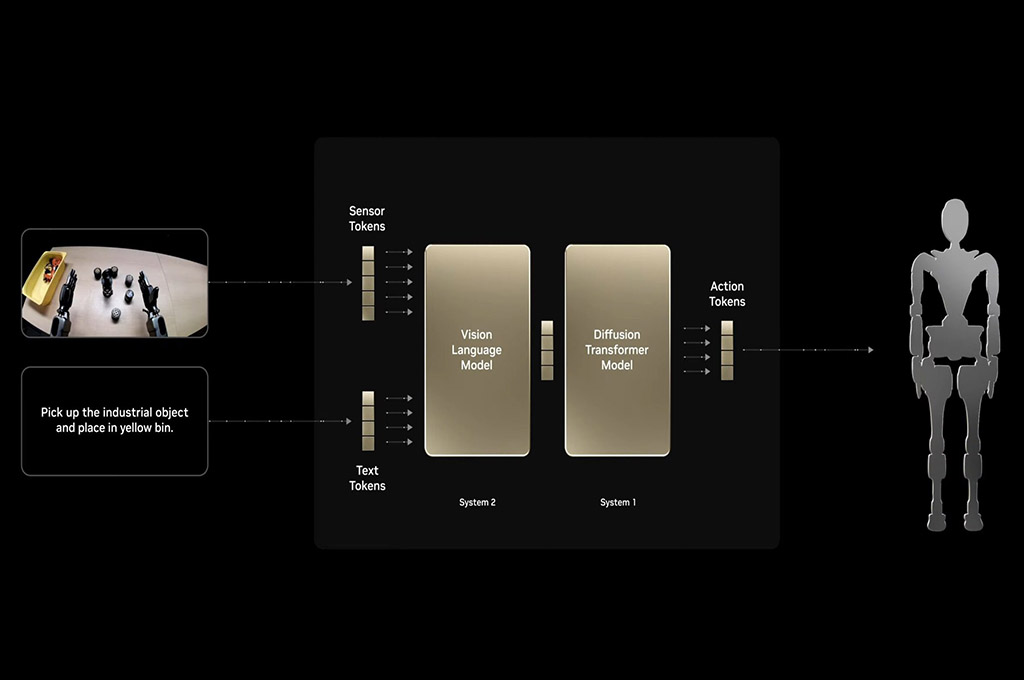Isaac GROOT N1: Powering Robot Intelligence

The world of robotics is on the cusp of a significant transformation, and at the forefront of this revolution stands NVIDIA with their ground-breaking Isaac GROOT N1. According to NVIDIA’s founder and CEO, Jensen Huang, “The age of generalist robotics is here,” and the introduction of Isaac GROOT N1, alongside innovative data generation and robot learning frameworks, signals a bold step into this new era. With the potential to address a global labour shortage exceeding 50 million, this technology promises to reshape industries and redefine the capabilities of automated systems. Let’s delve deeper into the intricacies of this exciting development.
Unleashing General-Purpose Robotic Skills
The core strength of the Isaac GROOT N1 lies in its ability to master a wide array of tasks with remarkable ease. NVIDIA states that this model, trainable on both real-world and synthetic data, can “easily” execute fundamental actions such as grasping and manipulating objects using single or multiple arms.
However, the true power of GROOT N1 emerges in its capacity to undertake complex, multi-step procedures that necessitate the integration of various general skills. This signifies a departure from traditional robots designed for highly specific tasks, paving the way for more adaptable and versatile robotic solutions capable of handling diverse and dynamic environments.
A Dual-System Architecture Inspired by Human Cognition
The architecture underpinning Isaac GROOT N1 is a fascinating reflection of human cognitive processes. It employs a dual-system approach, drawing inspiration from how our own minds function. “System 1” acts as a rapid-thinking action model, akin to human reflexes or intuition, enabling quick and immediate responses.
Conversely, “System 2” operates as a slower-thinking model, responsible for deliberate and methodical decision-making. This system, powered by a vision language model, can analyse its surroundings and the instructions it receives to formulate action plans. These plans are then translated by the fast-thinking System 1 into precise and continuous robot movements, creating a sophisticated and adaptable control mechanism.
Fuelled by Synthetic Data and Innovative Blueprints
A crucial aspect of developing robust generalist robots is the availability of vast and diverse training data. To overcome the practical limitations and expense of solely relying on real-world data collection, NVIDIA has introduced the Isaac GROOT Blueprint for generating synthetic data. This framework facilitates the creation of large, detailed synthetic datasets vital for training advanced robotic models.
By leveraging synthetic data, developers can expose their robots to a wider range of scenarios and edge cases, accelerating the learning process and enhancing the robustness of their algorithms. This innovative approach democratises robot development by reducing the reliance on costly and time-consuming real-world data acquisition.
The Power of Open Source Physics with NVIDIA Newton
Further bolstering the robotics development ecosystem is NVIDIA Newton, an open-source physics engine created in collaboration with Google DeepMind and Disney Research. This engine is specifically designed to cater to the unique demands of robot development, providing a realistic and accurate simulation environment.
Newton’s purpose-built nature allows developers to meticulously model the physical interactions of their robots with the world, enabling them to test and refine control algorithms and behaviours in a virtual setting before deployment in the real world. This open-source initiative fosters collaboration and accelerates innovation within the robotics community.
From Industrial Applications to Entertainment Spectacles
NVIDIA’s initial unveiling of Project GROOT at GTC 2024 primarily focused on industrial applications. The vision was for robots capable of learning and improving by observing human behaviour, understanding natural language, and emulating movements. This would enable them to rapidly acquire skills in coordination and dexterity, allowing them to navigate, adapt, and interact effectively within real-world industrial settings.
However, the potential applications of Isaac GROOT N1 extend far beyond the factory floor. During his GTC 2025 keynote, Jensen Huang was accompanied by Star Wars-inspired BDX droids, showcasing the exciting possibilities of this technology in theme parks and other entertainment venues. This highlights the versatility of generalist robotics and their potential to enrich various aspects of our lives.
A Future Shaped by Intelligent Automation
The introduction of NVIDIA Isaac GROOT N1 marks a pivotal moment in the evolution of robotics. Its ability to learn and execute a wide range of tasks, coupled with its innovative dual-system architecture and the support of powerful data generation and simulation tools, positions it as a key enabler of the generalist robotics era. As industries grapple with labour shortages and seek greater efficiency, technologies like Isaac GROOT N1 offer a promising path towards a future shaped by intelligent and adaptable automation. The journey has just begun, but the potential impact on our world is immense and undeniably exciting.

